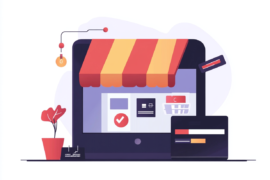This article may contain references to products or services from one or more of our advertisers or partners. We may receive compensation when you click on links to those products or services. Nonetheless, our opinions are our own.
The information presented in this article is accurate to the best of our knowledge at the time of publication. However, information is subject to change, and no guarantees are made about the continued accuracy or completeness of this content after its publication date.

Updated by Albert Fang
We often hear half of all businesses fail within the first year. However, that’s not entirely true. According to the Bureau of Labor Statistics, 20 percent of new companies won’t make it past the second year.
After five years, that number increases to 45 percent. A whopping 65 percent shut down during those first ten years.
A significant reason why these companies don’t survive comes down to finances. Within those first ten years, your business may be thriving, but it doesn’t take much to get off track. Even companies that are successful for the first few years can shut down before the decade’s end.
This likelihood of failure is especially the case if that business was trying to harness its success by scaling into new sectors without the financial plan to grow with stability. So even if you start with the capital you need to begin your company, and even if your sales are doing so well that you think it’s time to scale, you might not be prepared for the expenses that are coming next. But when you follow these tips, you’ll be able to scale without costs rising and overtaking your business.
-
8 Tips to Keep Your Costs Down While You Scale Your Business
- Invest in automation software for better cash flow.
- Utilize a financial suite to keep payments all in one place.
- Recognize that social media ads are no substitute for good SEO.
- Recognize when physical isn’t better.
- Prepare your taxes with professional help.
- Capitalize your software development.
- Be reasonable about your labor needs.
- Ditch your unused services
- Recommended Reads
8 Tips to Keep Your Costs Down While You Scale Your Business
Invest in automation software for better cash flow.
One aspect of scaling that gets overlooked is that many businesses don’t have plans for more money movement. When you scale, you should expect more payments coming in and a greater level of cash outflow.
If you don’t have anything ready to automate your accounts payable, your employees will spend more time on work that shouldn’t have to take up their day. More time wasted is more money lost by the whole company. Keep cash flow from being a constant headache for your team while increasing profitability. Growth will become stagnant without the right accounts payable systems if your finance team as your team becomes overwhelmed by your attempts to scale.
Utilize a financial suite to keep payments all in one place.
Whether you have a brick-and-mortar storefront or only exist online, the doors stay open due to customer payments. And as you scale, your goal is to see those payments scale as well. But more money coming in can overwhelm your company if your payment processes are all over the place. You need a financial suite that allows you to collect globally to target new markets and expand internationally. Because some of these suites charge high fees per transaction, look for one that offers lower rates.
You’d be hard-pressed to find a marketing manager today who says social media isn’t necessary to get noticed online. But too often, companies think scaling a business means putting more and more money behind social media ads and abandoning other parts of getting discovered online.
When we hear stories about brands going viral on TikTok and selling their inventory in minutes, it’s essential to understand these are the exceptions, not the rules. Paying for social media ads cannot replace optimizing your website for search. Driving organic traffic to your website makes a tremendous difference in your conversion rate, but it’s an inexpensive strategy that often gets set aside for more costly marketing campaigns.
For instance, consider how a restaurant’s search engine optimization (SEO) functions. When you have a craving for a specific food, you’re likely to head to a search engine and look up restaurants in your area that make the dishes you’re after.
Ninety percent of consumers research a restaurant before deciding to dine there. If your website is not optimized for search, your competitor may be the one they find, costing you potential customers. The higher you rank on a search engine, the more organic traffic you can expect on your website, increasing the depth of your customer base.
Recognize when physical isn’t better.
Companies can decide to exist in a physical space or online only in today’s world. For example, you may have an online storefront, and you may think scaling means bringing those products to a physical storefront.
However, doing so drastically increases your monthly costs. Similarly, if your team is remote and you think that, to scale, you need an in-person workspace, you’re now looking at the rent and other expenses incurred each month.
Companies that offer remote options expand their pool of prospective employees and end up saving more money per employee in the long run. Before deciding to make the jump to an in-person office space or opening an in-person shop, carefully consider if you’re ready for the cost and whether or not the price is worth it to your bottom line.
Your team may be thriving while remote, or your shop may be doing better as online-only.
Prepare your taxes with professional help.
You may think you know what to do to keep your tax bill low and your profitability high, but the savviest business people surround themselves with professionals in every field.
You’ll likely move through the tax brackets as you scale your business. And if you’re not saving enough profit to cover your new tax rate, you could soon find yourself underwater. So even if your background is in finance, consider hiring outside help with a team that has experience working with a scaling business. They can provide you with guidance that allows you to scale while still keeping your tax burden low.
Capitalize your software development.
When you capitalize the development costs of software you create for your business, you’re listing them as assets rather than expenses. This accounting method results in lower reported expenses and a higher bottom line.
Your asset balance will increase without your liability balance going up. If you choose to expense the costs, you might find yourself unable to get a new loan in the future. Especially when you’re scaling your business, you want to be mindful of anything that could prevent you from getting that financial boost down the road.
Although you hope you may not need that additional loan in the future, as a founder and CEO, you need to plan for any eventuality. And you may simply require that loan to expand to the size you’re hoping to achieve.
Be reasonable about your labor needs.
As you scale your business, you may be thinking that every team needs to increase its size. Or you may be considering that you’ll need to add new ones to keep up with expanding territories.
But before you go on a hiring spree to keep up with what you think will be the demands of your company’s future size, measure your company’s current performance.
What are your employees’ current workloads? What can increase? What can’t?
Before investing in new employees, consider outsourcing to help your team’s duties balance out with work from contractors. If the demand is there after using contractors for some time, you should invest in new staff members.
But it’s not worth taking the risk of hiring too much before your company has the chance to grow until it needs the added labor. Remember investing in an employee is about more than adding another salary to your yearly budget. It’s also about spending time and resources on training and offering additional benefits.
Ditch your unused services
Before you’re ready to expand, check in with your teams to see where they think they could cut costs. When a company starts, employees often invest in certain tools that they believe they’ll need to utilize to fulfill their duties. Especially when working with a bare-bones team, they may find that some hardware, software, and applications can supplement the labor of more colleagues.
But as more experts and professionals are hired, and the team’s growth surpasses what the tools provide, they become obsolete. But that doesn’t mean that those subscription costs just go away. They frequently continue to get paid month after month, draining your budget for no necessary reason. Talk to your employees about what tools they utilize and which ones are no longer serving them.
If a subscription gets used infrequently but occasionally, ask your employees to research alternatives that may have other capabilities they need. You’ll be paying fewer monthly costs but getting more for your money. There’s no sense in paying for something that only accomplishes one task when there are other applications that fulfill more of your needs.
When you scale your business, you open it up to potentially becoming one of the 65 percent of companies that fail in the first ten years. But you also open it up to targeting new markets, developing new services and products that bring in more income, and outpacing your competitor’s growth, as long as you don’t get swallowed by new and increasing costs.
It takes recognizing where to spend and where to save to keep your scaling company on track. But, with some professional help, automation, and SEO, you can keep your costs low and your team’s time focused on ways to increase profitability.

Reviewed and edited by Albert Fang.
See a typo or want to suggest an edit/revision to the content? Use the contact us form to provide feedback.
At FangWallet, we value editorial integrity and open collaboration in curating quality content for readers to enjoy. Much appreciated for the assist.
Did you like our article and find it insightful? We encourage sharing the article link with family and friends to benefit as well - better yet, sharing on social media. Thank you for the support! 🍉
Article Title: 8 Ways to Keep Your Costs Under Control As Your Business Scales
https://fangwallet.com/2022/05/31/8-ways-to-keep-your-costs-under-control-as-your-business-scales/The FangWallet Promise
FangWallet is an editorially independent resource - founded on breaking down challenging financial concepts for anyone to understand since 2014. While we adhere to editorial integrity, note that this post may contain references to products from our partners.
The FangWallet promise is always to have your best interest in mind and be transparent and honest about the financial picture.
Become an Insider

Subscribe to get a free daily budget planner printable to help get your money on track!
Make passive money the right way. No spam.
Editorial Disclaimer: The editorial content on this page is not provided by any of the companies mentioned. The opinions expressed here are the author's alone.
The content of this website is for informational purposes only and does not represent investment advice, or an offer or solicitation to buy or sell any security, investment, or product. Investors are encouraged to do their own due diligence, and, if necessary, consult professional advising before making any investment decisions. Investing involves a high degree of risk, and financial losses may occur including the potential loss of principal.
Source Citation References:
+ Inspo































![How to Hire Fintech Software Developers [Cost & Factors] fintech software engineers](https://fangwallet.com/wp-content/uploads/2025/03/fintech-software-engineers-270x180.png)












